IDEX Online Research: July Polished Diamond Prices Flat
August 05, 09
Global polished diamond prices held steady during July, based on the IDEX Online Polished Diamond Price Index. It appears that polished diamond prices bottomed in April, when the IDEX Online Index dipped to 108.40 points. Since then, prices over the past three months have remained in a tight trading range: 108.70 to 108.85 – with the IDEX Online Index averaging 108.84 for the month of July.
Many factors appear to be affecting polished diamond prices in the current recessionary environment.
- Rough diamond prices have risen, putting a lot of pressure on polished diamond suppliers to raise prices. Unfortunately, demand further down the distribution channel has not materialized, so polished prices have not moved higher.
- There was some optimism after the Hong Kong jewelry show and suppliers tried to implement higher prices for polished diamonds. However, these price increases did not hold, and dealers retreated to their former, lower prices.
- Demand at the JCK Las Vegas show was better than many dealers had expected, this helped to support prices in the polished diamond price market. However, since then, retailers have not placed firm orders at a pace sustaining higher prices for polished diamonds.
- At one point a couple of months ago, demand for larger stones – four carat and higher – picked up as Far East customers showed renewed interest in larger, high quality stones. However, this proved to be only a momentary event.
- There was little or medium demand for Diamond Trading Company (DTC) for 5-14.8 carat Sight boxes which produce two-to-eight carat polished diamonds.
- Demand worldwide for diamonds and diamond jewelry at retail remains soft as consumers have cut back on luxury purchases.
- Jewelry retailers cut back dramatically on re-orders for diamonds and diamond jewelry in an effort to conserve cash as well as align inventory levels more closely to sales trends.
- The decline in polished price demand is magnified at each step back up the pipeline, beginning at the retail level. While U.S. specialty jewelers’ sales are down only about 15 percent in 2009, some diamond miners report that demand dipped by as much as 90 percent earlier this year. The polished diamond market is only two steps removed from the mining market (with the rough diamond market in between these two markets). Thus, sales are weak, and demand does not support higher prices.
- Some polished diamond suppliers have dumped diamonds at depressed prices in an effort to raise cash. Dumping has offset price increases that some dealers attempted to implement.
- Finally, summer vacations began in July and will continue through August. Prices are likely to remain at current levels – or could drop – due to reduced market activity.
The good news is this: it appears that the sharp decline in polished prices is over, but price trends in July do not suggest that prices are headed higher. Consumer demand for luxury goods remains too uncertain, especially for the upcoming November-December 2009 Holiday Season to provide the impetus to push polished diamond prices higher from their current levels.
While vendors tell us that their order indications from the JCK Las Vegas Show and the JA New York Summer Show were “hopeful,” most suppliers did not receive a slew of orders causing them to run out and stock up on polished diamonds. In other words, diamond demand from retailers remains mixed at best. We believe that the worst is over, and that the signs point to a more optimistic – though perhaps subdued – near-term future for global polished diamond prices.
Short Term Polished Diamond Price Trend Stable
While signals from key global consumer markets are either mixed or slightly positive – with no market showing ongoing notable declines – it is likely that prices will at least hold steady, and perhaps firm up later this year. Some markets such as China are showing signs of an economic recovery. Even the U.S. market reports that economic activity appears to be picking up. Thus, longer term a gradual recovery of polished diamond prices will likely ensue. While polished diamond prices may remain subdued – or even test their prior lows – for a few more months, we strongly believe that they have bottomed, assuming there is no unforeseen shock to the system.
The graph below illustrates polished diamond prices for the past 24 months.
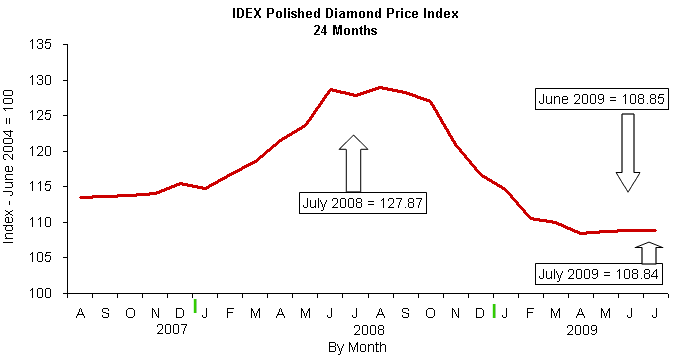
Source: IDEX Online
Monthly Polished Diamond Price Trends:
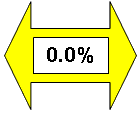 |
In contrast to May when larger diamond sizes showed modest price increases and June when smaller diamond prices crept up, diamond price increases – and decreases – were mixed in July. There was one notable price anomaly: the price of four-carat polished diamonds fell sharply the second day of the month and never recovered. We believe this may be related to mixed signals from Far East customers, as described earlier.
We believe history is a great forecaster for the future. If so, the rate of diamond price inflation would be expected to rise later this year or in early 2010, especially if demand turns out to be stronger than projected. However, we continue to believe that polished diamond price inflation will return to its historic norm of about 3-4 percent annually.
The IDEX Online Polished Diamond Price Index, calculated on the average daily prices during July 2009, stood at 108.84 for the month, roughly flat compared to 108.85 for the month of June 2009. On the last day of July, the IDEX Online Polished Diamond Price Index stood at 108.76, up from the 108.56 level registered on the first day of the month. The IDEX Online Polished Diamond Price Index stood at 100.00 in July 2004.
The graph below summarizes month-over-month changes in global diamond prices for the past thirteen months. Beginning in February 2008, polished diamond prices showed large gains during every month in the first half of the year. By mid-2008, price increases began moderating. In September 2008, polished diamond prices weakened, showing consistent month-to-month decreases, a trend that continued through the end of April 2009.
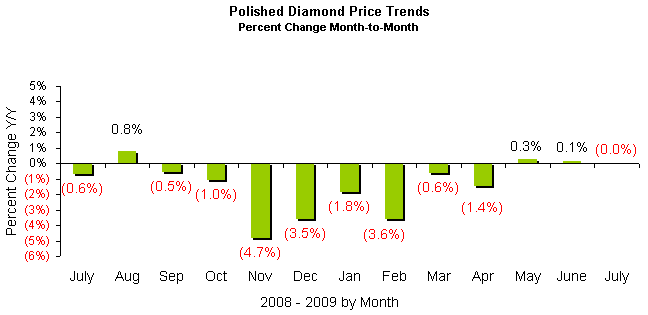
Source: IDEX Online
July 2009 versus July 2008: (14.9%) 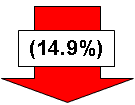
On a year-over-year basis, global polished diamond prices dropped by 14.9 percent in July 2009 versus the same month a year ago – July 2008. The IDEX Online Polished Diamond Price Index averaged 108.84 in July 2009 versus 127.87 in July a year ago. July was the seventh month that year-over-year prices dipped for polished diamonds. On a year-over-year basis, all key diamond sizes experienced price deflation, with large diamonds – three carat and up – showing much greater price deflation than diamonds below three carats in size.
The historical inflation rate of 3-4 percent annually is sustainable, in our opinion, over the long term. While some forecasters are predicting a “new normal” where conspicuous consumption will be out of favor and demand for luxury goods will be more muted. The merchandise mix will likely change – in favor of a unique look, rather than a large stone dangling from a neck chain – but overall jewelry demand won’t evaporate.
Finally, we believe that polished diamond prices will ultimately reflect market demand and supply; when demand begins to pick up, prices will also rise.
The graph below summarizes the year-over-year inflation rate by month for polished diamond prices in the global market for the past thirteen months. Comparisons are based on the daily average prices during the month versus the same month a year ago. The year-to-year comparison takes into account the seasonality of polished diamond demand and prices.
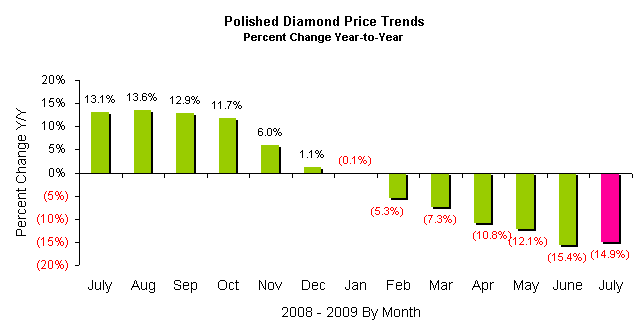
Source: IDEX Online
Day-to-Day Diamond Prices Steady-to-Upward
Polished diamond trading patterns in July on a day-to-day basis reflected reasonable seasonal demand, with little price fluctuation or volatility.
The graph below summarizes polished diamond prices on a daily basis for the past three months. Short of some kind of a system shock, we believe that polished diamond prices bottomed in April in the current cycle.
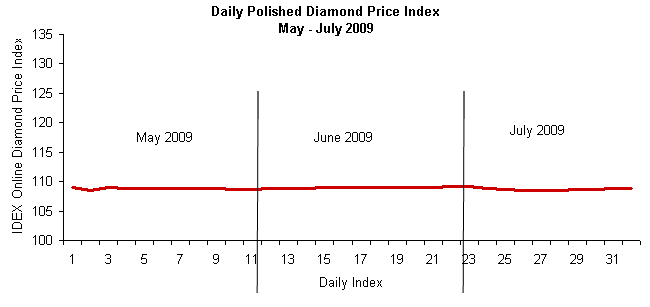
Source: IDEX Online
Polished Diamond Price by Size Are Mostly Steady
After rising rapidly in 2008, only to fall just as quickly at the end of the year, diamond prices by key sizes appear to have bottomed. Even more likely, we believe that they are poised to hold steady, and perhaps begin moving higher later this year or in early 2010.
The graph below summarizes price trends since late 2006 for the seven key diamond sizes; these diamonds represent just under one-third of the total value of the trading market.
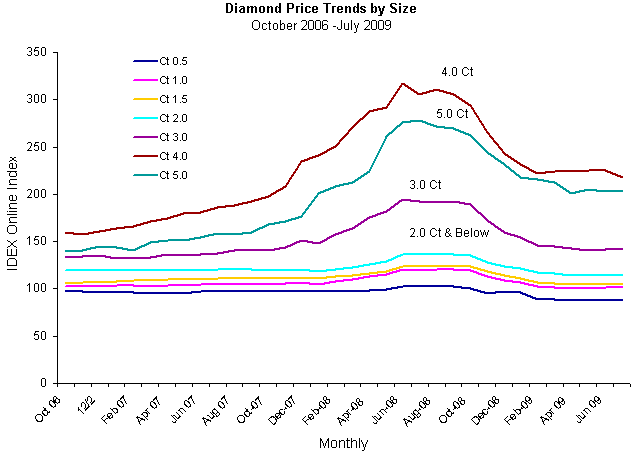
Source: IDEX Online
Month-to-Month Diamond Prices Mixed for Key Sizes
During July, month-to-month diamond prices by size were mixed, with some sizes showing a slight price increase while other sizes decreased in price. The big surprise was the dip in the price of four-carat polished diamonds – down 3.3 percent in the month. Many consumers have been opting for smaller diamonds, according to jewelers’ reports, as consumers tend to trade down, not out of the market. Many jewelers confirm that customer traffic is more or less holding up. Thus, prices for larger stones have been showing a greater decline than some of the other key sizes.
But here’s the key piece of news: prices really didn’t vary much by size on a month-to-month basis.
The following graph summarizes the price changes for key sizes of polished diamonds on July versus June basis. These seven diamond sizes represent about one-third of the trading market by value.
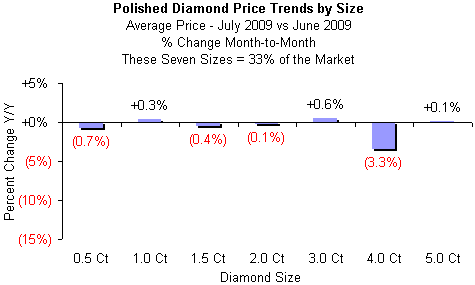
Source: IDEX Online
Year-Over-Year Diamond Prices for All Key Sizes Show Deflation
On a year-to-year comparison, polished diamond prices for the key sizes and qualities fell – some significantly – from the prior year. Virtually all sizes of diamonds showed a double-digit loss in price in July, though the decline overall was slightly smaller than June’s year-over-year weakness. Comparisons were difficult, since there were a string of double-digit price gains for the larger diamond sizes in the summer of 2008.
The graph below summarizes polished diamond prices by key sizes on a year-over-year basis: July 2009 versus July 2008.
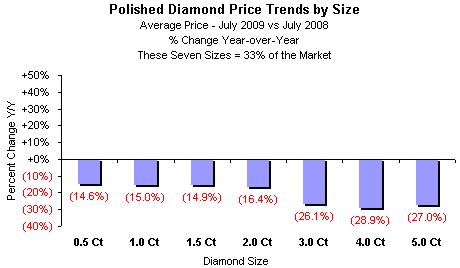
Source: IDEX Online
Forecast: Diamond Prices Have Bottomed in Current Cycle
We believe that month-to-month polished diamond prices will likely show flattish or perhaps modestly positive comparisons in subsequent months. As a result, year-over-year price comparisons will likely begin to show less disappointing comparisons by the early fall. At some point, probably in late 2010 or early 2011, we believe that diamond price inflation will recover to its historic trend line, reflecting annual inflation of 3-4 percent.
The U.S. market consumes roughly half of the world’s diamond jewelry. Its economy is showing some vitality, after significant weakness over the past year. Further, other regional economies around the globe are also showing some signs of recovery. Along with these recoveries, consumers will resume purchases of luxury goods, though at a pace below historic levels initially.
The IDEX Online Diamond Price Index
The IDEX Online Diamond Price Index is a real-time index derived from actual asking prices in the global diamond industry. The IDEX Online Diamond Price Index objectively reflects price trends as they happen. The Diamond Index and Diamond Drivers were formulated following comprehensive research and analysis of the IDEX Online inventory database, aggregated since 2001. Research and development were conducted in cooperation with Dr. Avi Wohl, Senior Lecturer of Finance at the faculty of Management, Tel Aviv University, Israel.
Additional information is available from IDEX Online Research by email.